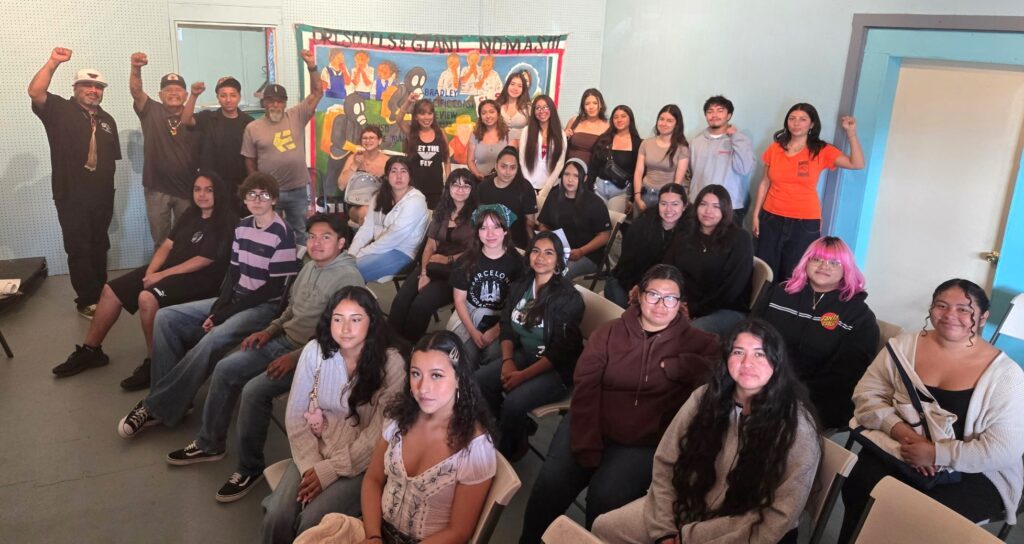
Sept. 30, 2025—Omar Dieguez’s ongoing hunger strike/talking tour, to protest pesticide use near Pajaro Valley schools and communities, reached 30 days—three zero—today (Sept. 30).
The most difficult part hasn’t been the sleepless nights, fatigue brain or even the intestinal pain that sent him to the hospital for malnourishment.
In fact, that’s all turned out pretty manageable. (Experience more details from his hunger strike with the companion piece, “11 Intense Thoughts From 30 Days of Hunger.”)
And he’s finding other ways to fill up.
“The community outpour has been big—very big—and that is motivating,” he says.
For Dieguez, who works with nonviolence-social justice-community empowerment nonprofit Barrios Unidos, the greatest stress emerged from censorship.
A few of his hometown area’s high schools prevented him from sharing his educational message with students who happen to live close to fields treated with pesticides that are linked to cancer, in a region with some of the highest pediatric cancer rates in the state. (Pajaro Valley Unified School District Public Information Officer Alejandro Chavez notes the district is reviewing what he admits might be an outdated approach to “controversial” topics.)
The emotion is audible in Dieguez’s voice when he says, “Not being able to share my message with students breaks my heart.”

Dieguez’s presentation deserves a listen from all Californians, and those who live near conventionally farmed fields in particular, in part because it transcends poison, but provides antidotes.
He opens the talk with a request to burn sage, grabbing audience attention and inviting both departed ancestors and peers lost to cancer or gang violence to swing back around and join in.
“The empty chairs aren’t a coincidence,” he says.
Then he asks students to close their eyes while he plays his indigenous flute. Before they open their eyes—in a literal sense—he prompts them to picture someone or something that makes them happy, to smile, and to face their neighbor.
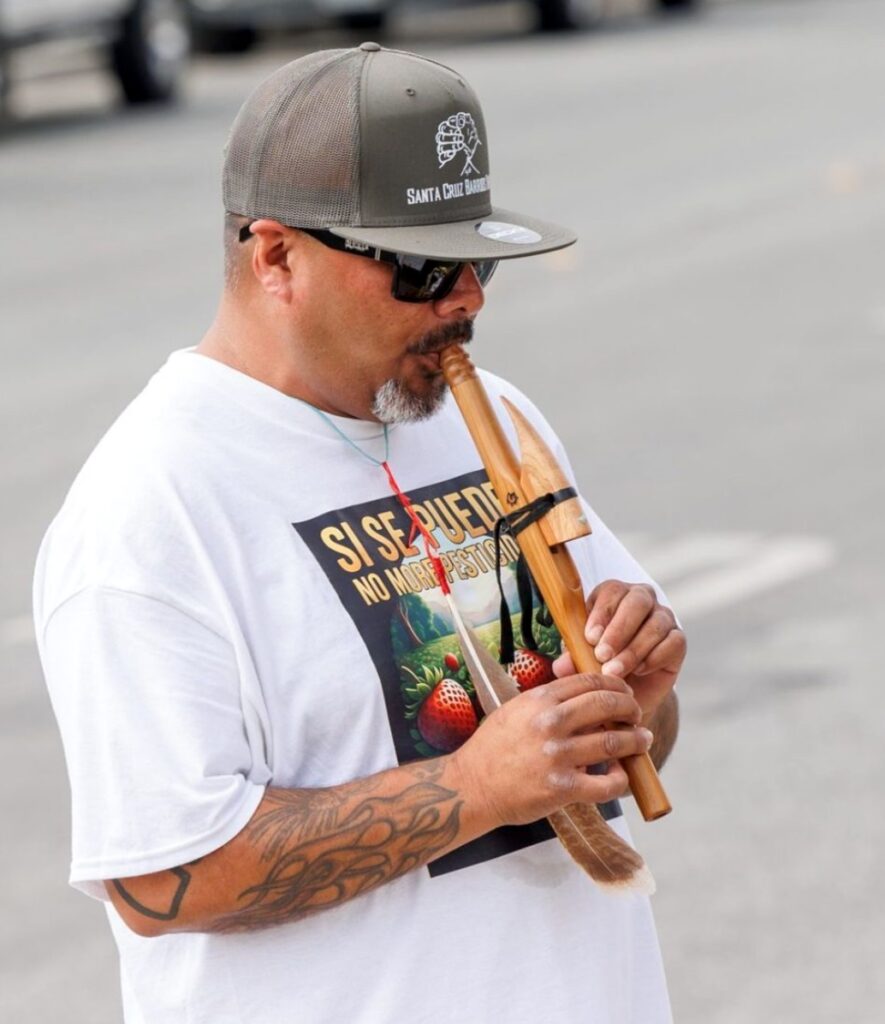
“It’s a great way to get started, and when they open their eyes looking at one another they all end up giggling,” he says. “I explain why it’s important to smile, even when you’re having a bad day, or to just in front of mirror, because it tricks the brain and releases good feels—endorphins—and when you smile at somebody, you’re not just making you feel good, it makes someone else feel good, and we can always be kind.”
From there his talk covers a lot of acreage.
How he navigated discrimination as a minority teen bussed to mostly white Aptos by organizing and becoming the school’s first brown student body president in its then 20-year history.
How verified maps show the proximity between local schools and fumigated fields.
How many Jacob’s Heart pins, dedicated for kids with childhood cancer, pierce the landscape around Pajaro and Salinas valleys.
How his rendition of the “Happy Woman Warrior Song” on the drums can have smile-sharing effects.
How farmworkers aren’t often warned of the risks pesticides present, or when they’re deployed.
How the first to hug their chemical-carrying clothing when they get home are young kids.
How—and why—he decided to stop eating, starting with growing up surrounded by sickness haunting his farmworking friends, neighbors and family members.
Then come the questions—“What’s first thing you’re going to eat?” “What do your parents think about this?” and the most common, “How can we get involved?
He describes strategies like writing letters and attending school board meetings, and the wider philosophy behind that.
“Don’t let anyone ever tell you you can’t do something in life,” he says. “If you have a dream, and one person says no, find a way around it.”
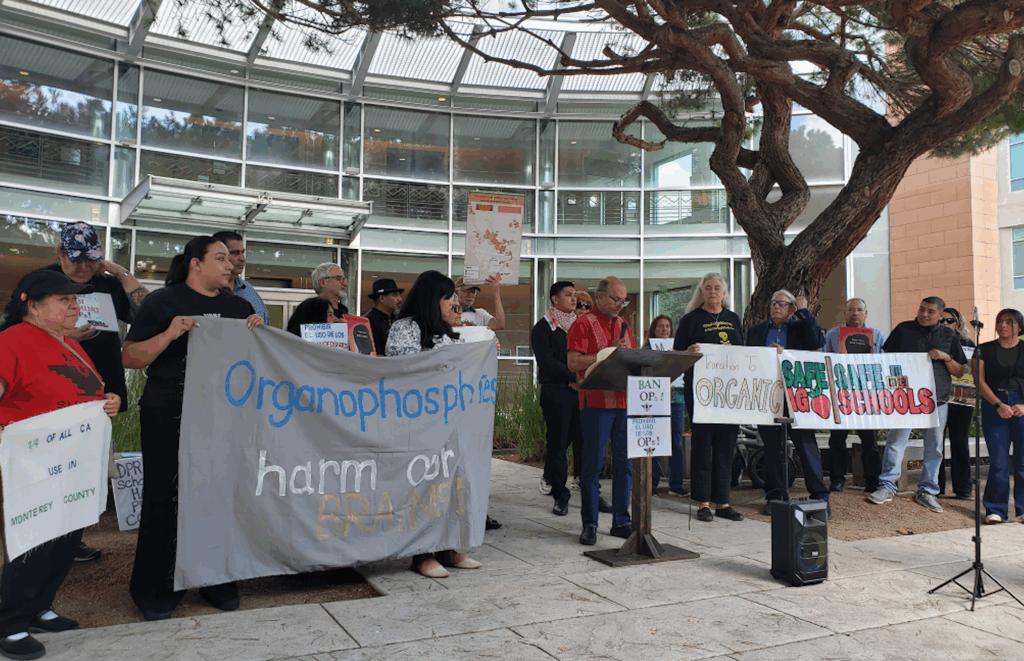
A few hours before this piece published, Dieguez joined a press conference at the County Government Center in Salinas announcing new findings around pesticide impacts.
He gathered with reps from Safe Ag Safe Schools, Californians for Pesticide Reform, Future Leaders of Change and the California League of United Latin American Citizens.
Their hope was to draw awareness to results of peer-reviewed research published today by scientists at the Public Health Institute’s Tracking California and UC Berkeley’s Center for Environmental Research and Children’s Health.
“Temporal trends of agricultural organophosphate pesticide use in California and proximity to pregnant people in 2021” can now be viewed by the public.
The top line takeaways: More than half of all pregnant women giving birth in Monterey County in 2021 lived within 1 kilometer of ag fields where organophosphate pesticides (OPs) were applied during their pregnancies, compared to 7.5% of all pregnant women statewide. OPs are linked to lower IQ, neurodevelopmental problems, and lung damage in developing children.
“If you want to keep a community down, put organophosphates in it,” Dieguez said at the news conference. “This has got to stop.”
Independent public health researcher Miriam Rotkin-Ellman, lead author of the study, says she came to the work because it seemed like a clear priority.
“I’m very interested in environmental health and public health because it answers a lot of questions around what people are worried about,” she says, “and matter for communities, their lives and children’s lives.”
Rotkin-Ellman adds that she wasn’t surprised Monterey County was a hot spot, given the intensity of its ag output.
What was surprising to her? While there was a decrease in use of OP pesticides across the state in the 5 years measured, in Monterey County, it increased, and continues to.
“That’s a huge burden,” she says. “That’s a community paying the price for agriculture.”
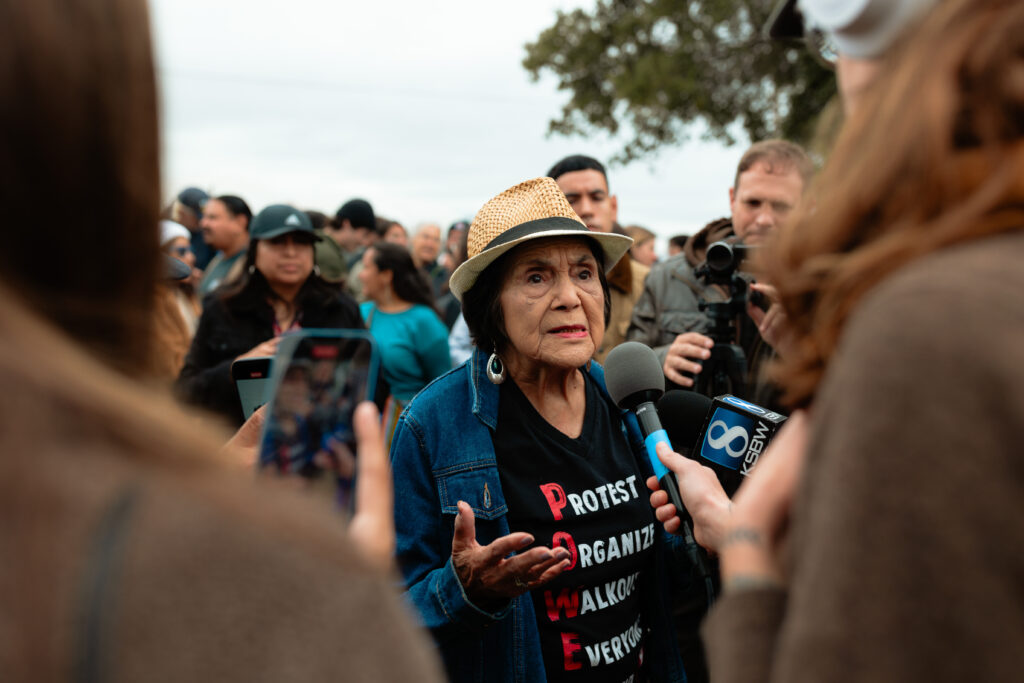
Logic would suggest science connecting pesticides to human damage—on top of soil, flora and fauna destruction—would be enough to activate change.
That had me revisiting a related thought from reporting “Grounded Solutions: Finding Fairness, Avoiding Pesticides and Advocating Sense in the Pajaro Valley,” which published this summer.
The piece starts with this:
Dolores Huerta stands at a temporary podium on a dirt road in Watsonville, with a farm treated with pesticides on one side, and MacQuiddy Elementary School on the other.
You’d think the juxtaposition would be enough to inspire action, given the links between childhood cancer and chemicals used at the farm, including chloropicrin, malathion and 1,3-dichloropropene.
If that isn’t enough, there’s also the fact Huerta, the 5-foot-tall giant in the United Farm Workers (UFW) movement, still has this self-evident problem to call out.
The moment comes a half century after she launched UFW with Cesar Chavez, and a month after she celebrated her 95th birthday.
“There is no reason [growers] have to use pesticides,” she says. “Organic farmers have proven that you can grow food without it for centuries.”
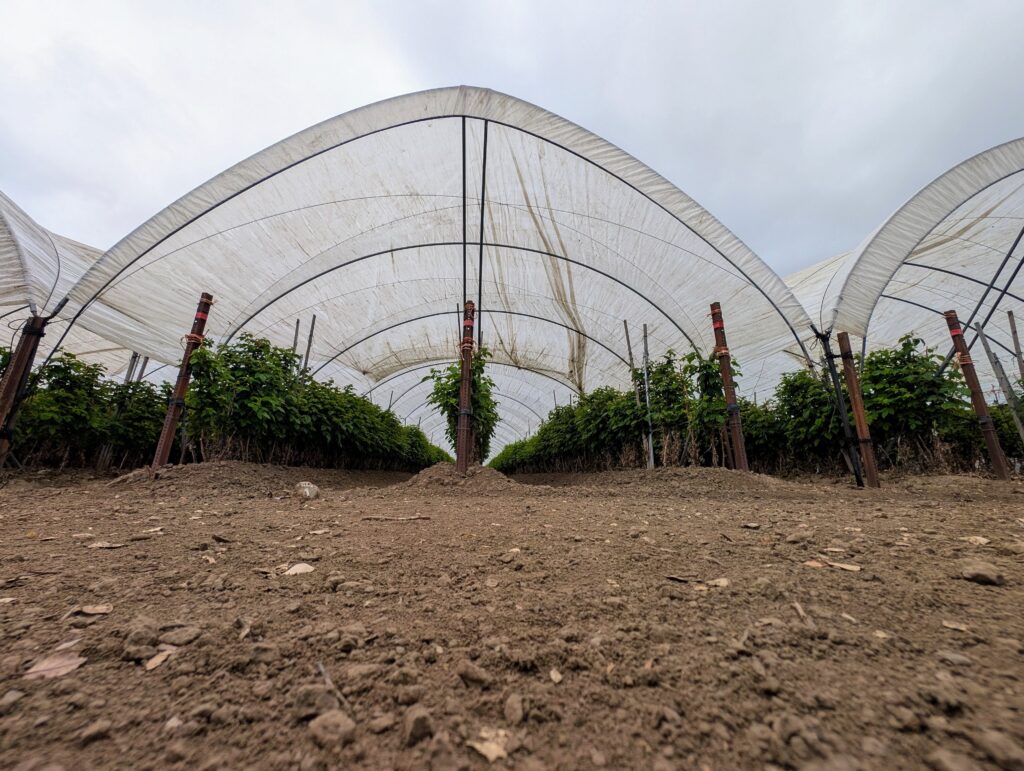
That same story ends with some ways to help, which reappear here.
1. CHECK THE MAP.
The fumigant 1,3-dichloropropene is banned in 34 countries. That’s one of a number of toxins the Campaign for Organic & Regenerative Agriculture (CORA) tracks with colorcoded grids, noting 1 million pounds of pesticides are applied in Santa Cruz County annually, all too often on agricultural fields near schools and homes in the Pajaro Valley.
A seven-panel infographic on CORA’s page at farmworkerfamily.org/cora spotlights the scary-close proximity, which contributes to the county having the second-highest pediatric cancer rates in the state.
2. TAKE A TOUR.
The homespun Center for Farmworker Families (CFF) voyage moves through organic farms and the Buena Vista Migrant Center, experiences lived and person-to-person interaction.
The insight communicated proves sobering and inspiring, as recent visitor and Jesuit theology professor Dr. Mary E. McGann observes.
”The tour is empowering for those interested in what they can do to help,” she says. “It’s also moving given the incredible sense of courage and endurance the workers—all of them women—convey.”
3. VOLUNTEER WITHOUT FEAR.
CFF coordinates with Watsonville police to avoid any potential U.S. Immigration and Customs Enforcement (ICE) interference when CFF shares pantry items, detergent, diapers and food, among other items, at its monthly distribution gatherings.
Volunteers are welcome to help gather and disperse goods, farmworkerfamily.org/volunteer-program.
4. STUDY THE WINDS.
SprayDays California, launched in March 2025, is a first-of-its-kind statewide system that informs when and where restricted pesticide applications will take place, spraydays.cdpr.ca.gov.
5. SHARE STUFF.
All area locals are encouraged to donate clothes, toiletries, house supplies—basically anything of use—to CFF. “Everything we receive,” one volunteer says, “we give out.”
6. PROVIDE DIRECT SUPPORT.
CFF accepts tax-deductible donations.
7. BUY ORGANIC.
Voting no on pesticides can be as simple as prioritizing organic produce.
Fortunately the Monterey Bay area enjoys dozens of mindful growers like Lakeside Organic Gardens, the largest familyowned and -operated, 100% organic vegetable operation in the United States.
In so doing, shoppers can honor the wisdom one old farmer shares with Edible: “Why would you want to eat something a bug wouldn’t?” he asks, adding, “or that would kill it?”
CORA chief Adam Scow offers more motivation: “This isn’t just a public health threat. It’s about fumigating the soil, which kills it. We’re also fighting for the future of farming.”
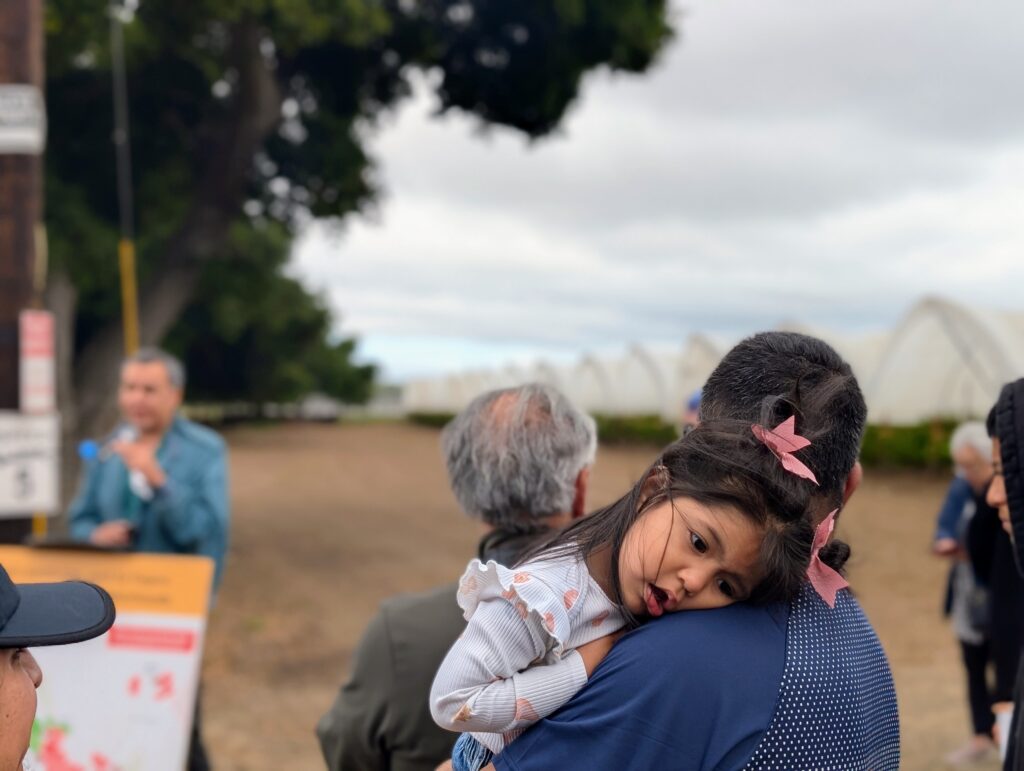
Omar Dieguez contends there haven’t been a ton of plot twists across a month devoid of eating and full of public speaking, from Esperanza Farms to Cabrillo College to UC Berkeley and back.
“Nothing really surprised me,” he says. “What I expected was for a lot of people to become aware of the problem, and to join. I knew once they stated hearing and learning, they would.”
But there have been at least two he didn’t see coming.
He shared the first one Day 16, which he might not recall—because…nutrients—when he told me he didn’t expect elementary-schoolers to be “more aware of the harms of pesticides than the older kids.”
“Their concern is, ‘What’s going to happen to my parents?’” Dieguez said. “They want to do something.”
Surprise #2: His original hunger-strike stop date (today, Sept. 30) now represents the 2/3rd point.
During his hospitalization he was diagnosed with an infection, and the medicine prescribed to restore him keeps him on a liquid diet for another 15 days. So the strike continues, in an organic way.
One surprise for me: After 30 days without food, and now another two weeks ahead, Dieguez believes the real challenges still await.
“I’m glad my hunger strike is closer to being over,” he says. “But the hard work is to come, connecting with all these people, bringing them all together. The strike’s going to end, but the work is going to continue until we see change.”
About the author
Mark C. Anderson, Edible Monterey Bay's managing editor, appears on "Friday Found Treasures" via KRML 94.7 every week, a little after 12pm noon. Reach him via mark@ediblemontereybay.com.
- Mark C. Andersonhttps://www.ediblemontereybay.com/author/markcanderson/
- Mark C. Andersonhttps://www.ediblemontereybay.com/author/markcanderson/
- Mark C. Andersonhttps://www.ediblemontereybay.com/author/markcanderson/
- Mark C. Andersonhttps://www.ediblemontereybay.com/author/markcanderson/



